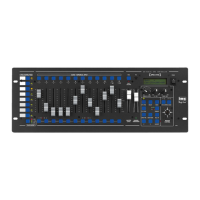
Do you have a question about the IMG STAGE LINE DMX-1440 and is the answer not in the manual?
| Brand | IMG STAGE LINE |
|---|---|
| Model | DMX-1440 |
| Category | DJ Equipment |
| Language | English |
Describes channel selectors, numerical keys, display, faders, and various controls for operation.
Details the DMX signal outputs and stereo audio input port.
Covers electrical hazards, environmental protection, proper handling, and servicing precautions.
Explains DMX technology, 96 control channels, DMX addressing, and channel mapping.
Highlights flash, blackout, master fader, control lever, scene memory, and sequence features.
Covers unit placement, connecting DMX/audio, and setting DMX start addresses.
Details DMX patching, channel options, inversion, and reset functions.
Covers setting scenes using faders, controls, and the master level.
Explains how to use the control lever for specific channel pairs as an alternative to faders.
Describes how to dim the overall scene brightness using the MASTER LEVEL fader.
Explains using flash buttons and flash groups to set channels to maximum brightness.
Describes how to use the blackout function to darken the scene.
Explains how to view current channel values without using the controls.
Covers using the hold mode and crossfading to the next scene.
Details the process of saving scene settings into memory banks and scenes.
Explains how to select banks and scenes and initiate crossfading.
Describes how to stop an ongoing crossfade using the HOLD button.
Explains how to reserve the subsequent scene during a crossfade.
Covers selecting, deleting, and modifying sequence steps and times.
Details how to choose a sequence number for programming or modification.
Explains how to delete an existing sequence or start a new one.
Covers adding or modifying individual steps within a sequence.
Explains how to insert new steps into an existing sequence.
Details how to remove individual steps from a sequence.
Covers selecting and starting a scene sequence.
Summarizes scene adjustment, manual crossfading, and flash button functions.
Covers memorizing and calling scenes, managing sequences, and their playback modes.
Briefly explains channel configuration options like Master Dependency, Crossfade, Blackout, and Full/Flash.
Lists DMX output, audio input, music control, DMX addresses, channels, memory, sequences, time, display, power, temp, dimensions, weight.
Explains channel grouping, master dependency, crossfade, blackout, and flash options.
